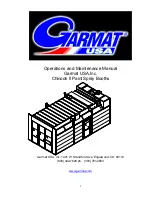
Block Diagrams
Theory of Operation
2 - 24
0070-00-0420
Passport 5-Lead, 5L, LT, XG Service Manual
Aynchronous Serial Interface (SPI)
The synchronous serial port, known as the SPI (Serial Peripheral Interface) is used to interface
the A/D converter. The SPI signals are provided in four of the lines in port D. The interface
consists of a shift register with both serial and parallel I/O. In operation, parallel data is first
written to the register, internally in the microcontroller. The generation of eight clock pulses
shifts this data out of the register and into an external peripheral. If this peripheral generates
data, it can be simultaneously shifted into the register. A parallel read of the register will then
provide the input data to the microcontroller. The A/D converter has a serial interface which
is nominally compatible, with the SPI. Note that the clock inputs of the SPI as well as the A/
D converter are connected to port C bit 0. The converter chip select is connected to port C bit
1. The SS line of the SPI, which enables operation when in the slave mode, is hardwired
active low. In operation, the software loads the data to be sent to the ADC (multiplexer
address) into the SPI register. The chip select line is then brought active low, and software
pulses port C bit 0 eight times, generating eight clocks. This transfers the data from the SPI to
the ADC, and loads the eight ADC msb’s into the SPI. The software then reads these bits
from the SPI, saves them, and generates 2 more clocks. The chip select line is then made
inactive, as the ADC has received its exact 10 clocks. Then, with the ADC disabled, six more
clocks are generated, so that the SPI receives a second complete set of eight. At this point,
the SPI contains the two msb’s from the ADC, as well as six undefined bits, which are
discarded.
A/D Converter
The data interface to the A/D converter has been described above, in conjunction with the
microcontroller SPI. The data output line of the A/D converter (U39) is provided with a pullup
resistor (R88) because it becomes tristated whenever the A/D chip select in inactive. In
addition to the digital signals required by the data interface, a clock signal is required for the
actual conversion process. This is obtained from CMOS counter U40, which divides the
microcontroller oscillator by 2, providing a clock of nominally 1.84 MHz. The counter also
provides the oscillator frequency divided by 32. This signal, at nominally 115 KHz, is used
by the respiration block for developing patient RF drive.
The analog inputs are selected by an internal multiplexer. Only eight of the eleven possible
channels are used, with the remainder being grounded. This configuration allows pin-
compatibility with a 12 bit converter IC. Five of the inputs monitor the patient ECG,
respiration, temperature, and the two pressures. The blocks supplying these signals can
swing beyond the 0 to +5 volt input range of the A/D converter, and must therefore be
limited to prevent malfunction or even destruction of the device. This is provided by a series
of diodes which are connected between each of these signals and both +5 and ground.
These diodes clip the signals to the safe levels. The signal sources have series resistors of
2.2K or greater, which satisfy this requirement.
The A/D converter is of the successive approximation charge redistribution type. It features
an internal capacitor ladder network which is charged from the signal source when the
multiplexer samples a signal.
Содержание Passport 5-Lead
Страница 1: ...Service Manual 5 Lead 5L LT XG Datascope Passport 0070 01 0420 indd 1 4 11 11 4 45 PM...
Страница 2: ...5 Lead 5L LT XG Service Manual Datascope Passport 0070 02 0420 indd 1 4 11 11 4 45 PM...
Страница 324: ...5 4 0070 00 0420 Passport 5 Lead 5L LT XG Service Manual This page intentionally left blank...
Страница 502: ...6 100 0070 00 0420 Passport 5 Lead 5L LT XG Service Manual This page intentionally left blank...
Страница 544: ...0070 00 0420 Rev T April 13 2011...
















































